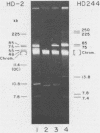Abstract
A 75-kilobase plasmid from Bacillus thuringiensis var. kurstaki (HD-244) was associated with the k-73 type insecticidal crystal protein production by mating into B. cereus and subsequent curing of excess plasmids. This plasmid was partially digested with endonuclease R · Sau3A and the fragments were cloned into Escherichia coli (HB101) on vector pBR322. Candidate clones were screened for plasmid vectors which contained the expected insert size (at least 3 kilobases) and then with an enzyme-linked immunosorbent assay, using antisera prepared against electrophoretically purified, solubilized insecticidal crystal protein of 130,000 daltons. Several positive clones were isolated and were analyzed for expression, toxicity, and genetic content by restriction enzyme analysis. Electrophoretic transfer blots of proteins from a candidate E. coli clone, analyzed by enzyme-linked immunosorbent assay, demonstrated a predominant cross-reacting protein of about 140,000 daltons. Ouchterlony analysis also showed a single precipitin band. Extensive bioassays with Manduca sexta larvae revealed that the E. coli clones make toxin with a specific activity (50% lethal dose per microgram of cross-reacting protein) equivalent to that of the parental B. thuringiensis strain or a B. cereus trancipient carrying the toxin-encoding, 75-kilobase plasmid.
Full text
PDF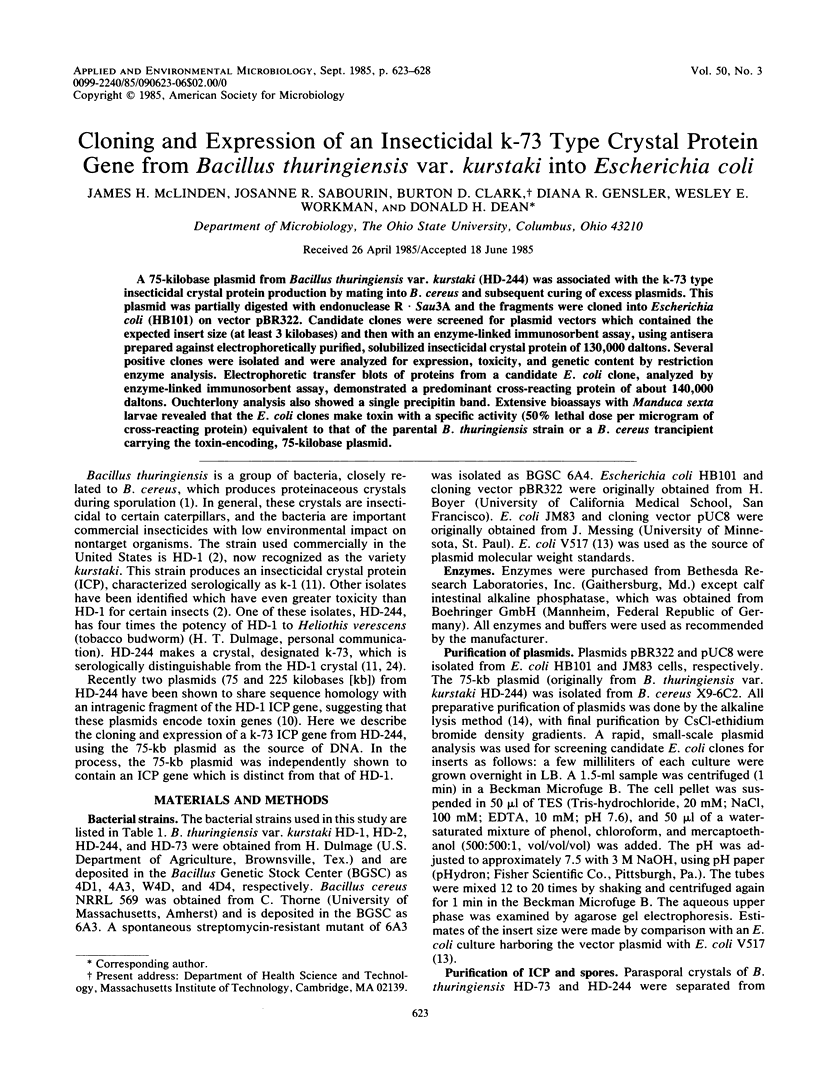
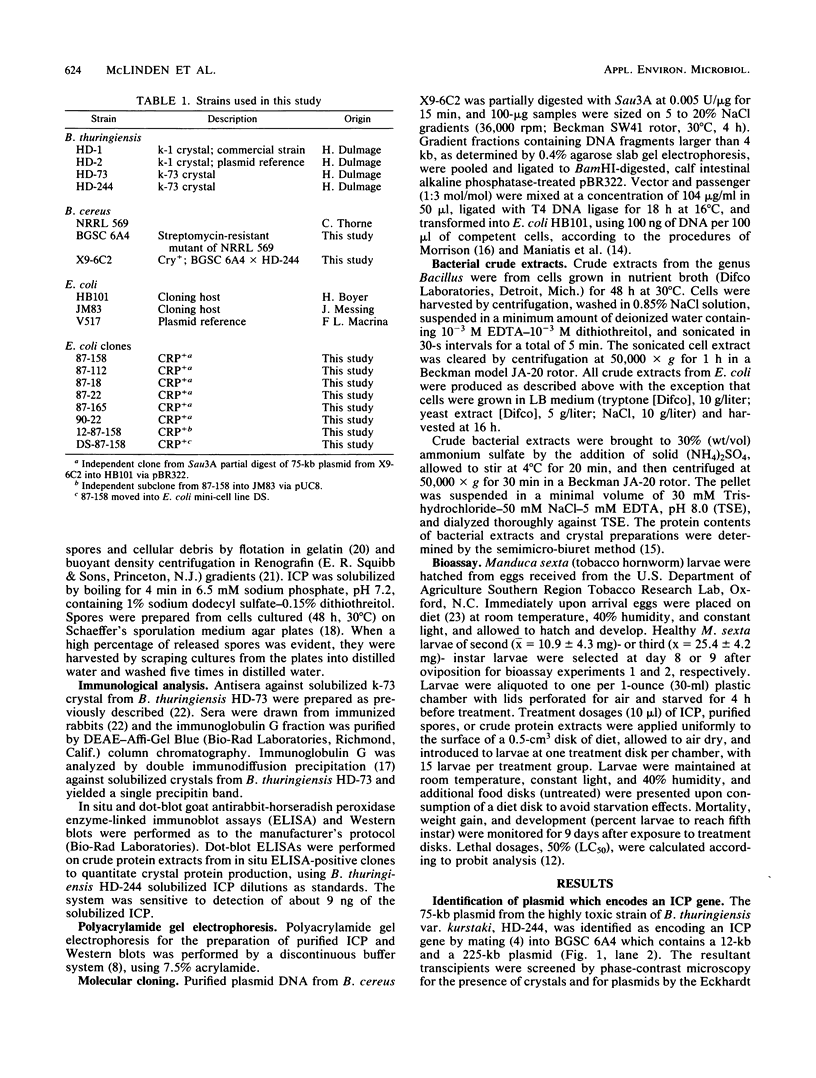
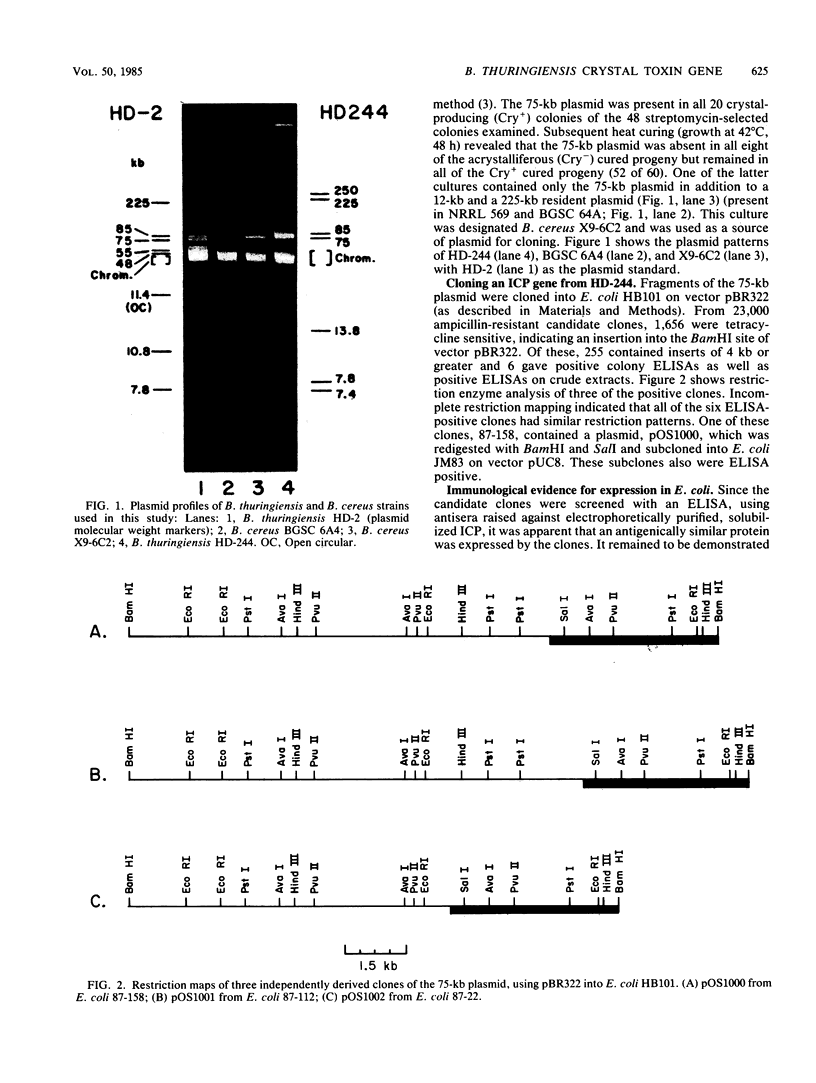
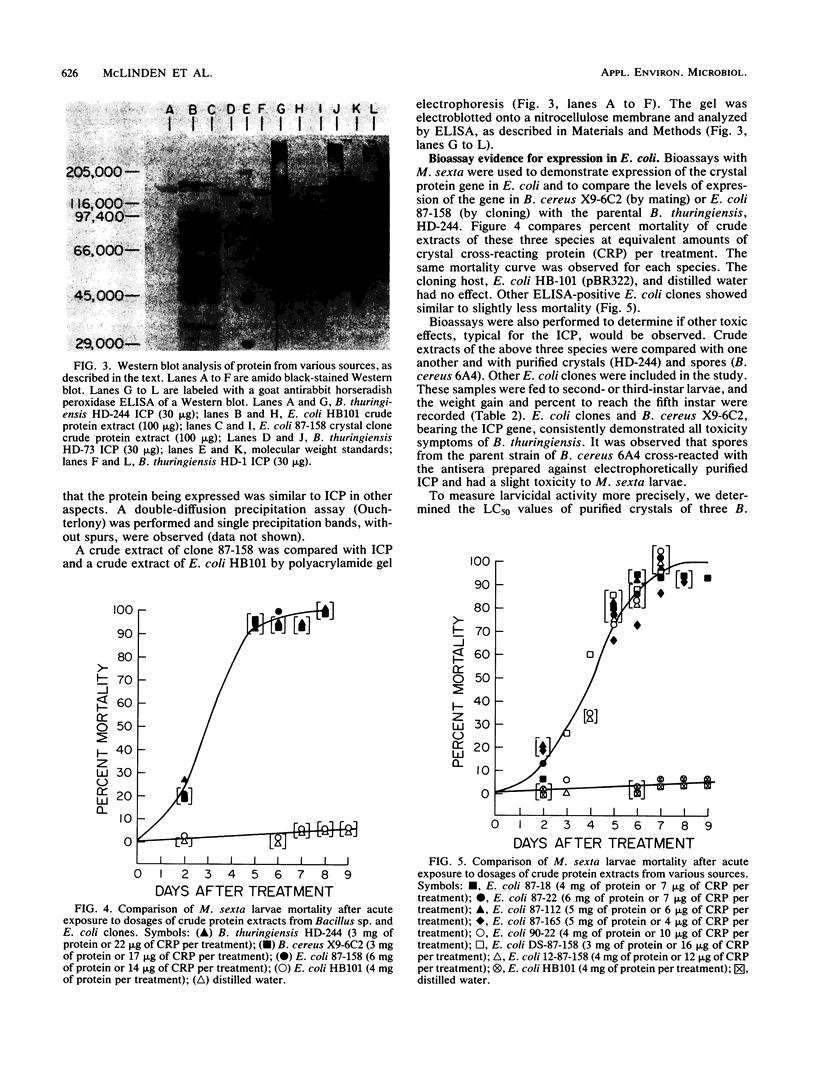
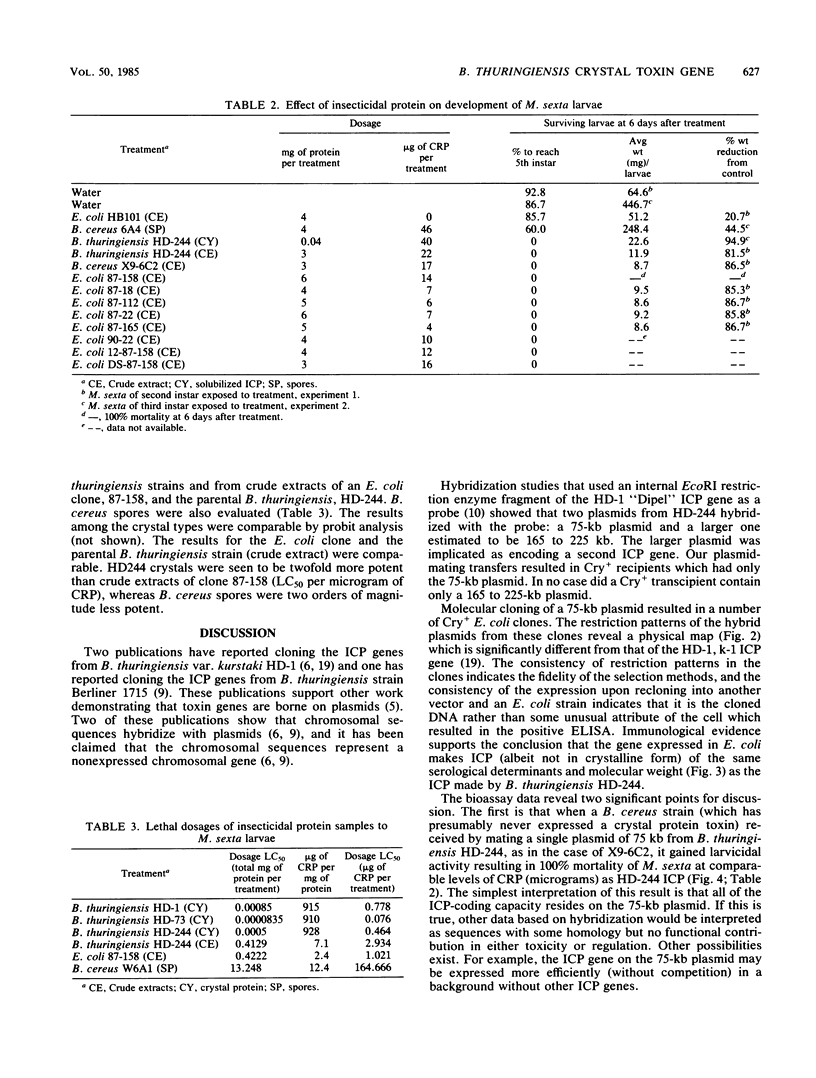
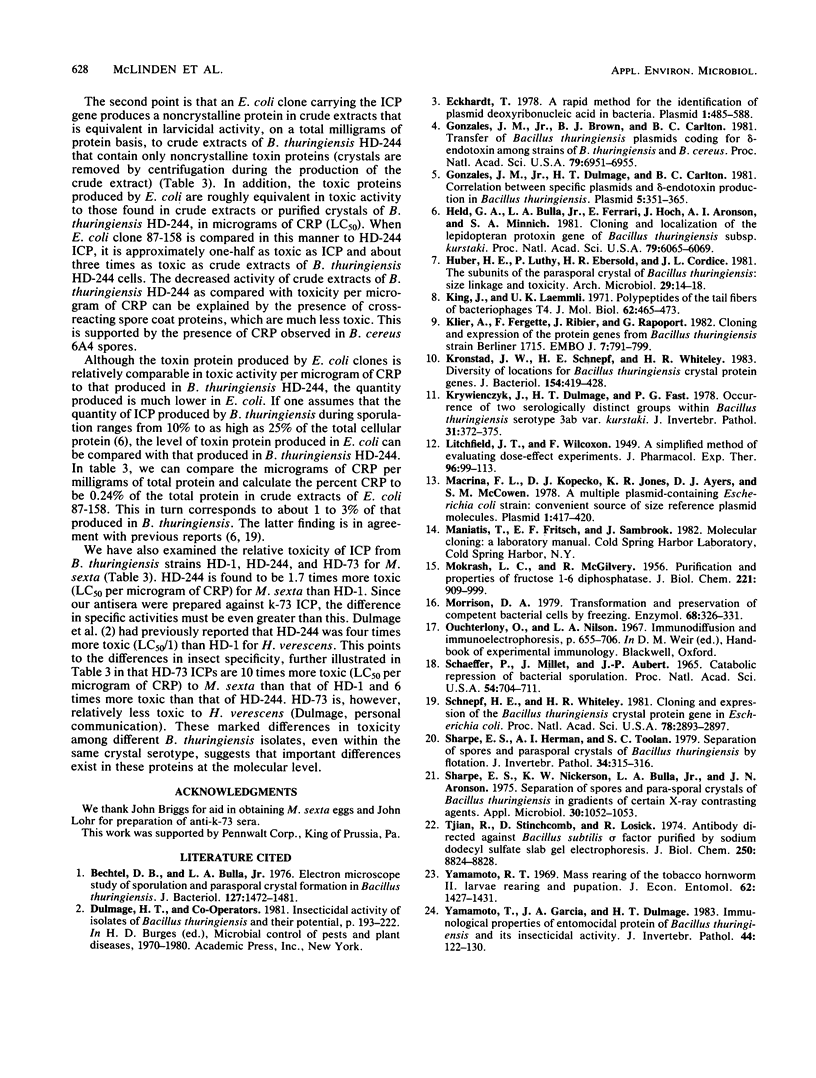
Images in this article
Selected References
These references are in PubMed. This may not be the complete list of references from this article.
- Bechtel D. B., Bulla L. A., Jr Electron microscope study of sporulation and parasporal crystal formation in Bacillus thuringiensis. J Bacteriol. 1976 Sep;127(3):1472–1481. doi: 10.1128/jb.127.3.1472-1481.1976. [DOI] [PMC free article] [PubMed] [Google Scholar]
- Eckhardt T. A rapid method for the identification of plasmid desoxyribonucleic acid in bacteria. Plasmid. 1978 Sep;1(4):584–588. doi: 10.1016/0147-619x(78)90016-1. [DOI] [PubMed] [Google Scholar]
- González J. M., Jr, Brown B. J., Carlton B. C. Transfer of Bacillus thuringiensis plasmids coding for delta-endotoxin among strains of B. thuringiensis and B. cereus. Proc Natl Acad Sci U S A. 1982 Nov;79(22):6951–6955. doi: 10.1073/pnas.79.22.6951. [DOI] [PMC free article] [PubMed] [Google Scholar]
- González J. M., Jr, Dulmage H. T., Carlton B. C. Correlation between specific plasmids and delta-endotoxin production in Bacillus thuringiensis. Plasmid. 1981 May;5(3):352–365. doi: 10.1016/0147-619x(81)90010-x. [DOI] [PubMed] [Google Scholar]
- Held G. A., Bulla L. A., Jr, Ferrari E., Hoch J., Aronson A. I., Minnich S. A. Cloning and localization of the lepidopteran protoxin gene of Bacillus thuringiensis subsp. kurstaki. Proc Natl Acad Sci U S A. 1982 Oct;79(19):6065–6069. doi: 10.1073/pnas.79.19.6065. [DOI] [PMC free article] [PubMed] [Google Scholar]
- King J., Laemmli U. K. Polypeptides of the tail fibres of bacteriophage T4. J Mol Biol. 1971 Dec 28;62(3):465–477. doi: 10.1016/0022-2836(71)90148-3. [DOI] [PubMed] [Google Scholar]
- Klier A., Fargette F., Ribier J., Rapoport G. Cloning and expression of the crystal protein genes from Bacillus thuringiensis strain berliner 1715. EMBO J. 1982;1(7):791–799. doi: 10.1002/j.1460-2075.1982.tb01249.x. [DOI] [PMC free article] [PubMed] [Google Scholar]
- Kronstad J. W., Schnepf H. E., Whiteley H. R. Diversity of locations for Bacillus thuringiensis crystal protein genes. J Bacteriol. 1983 Apr;154(1):419–428. doi: 10.1128/jb.154.1.419-428.1983. [DOI] [PMC free article] [PubMed] [Google Scholar]
- Krywienczyk J., Dulmage H. T., Fast P. G. Occurrence of two serologically distinct groups within Bacillus thuringiensis serotype 3 ab var. kurstaki. J Invertebr Pathol. 1978 May;31(3):372–375. doi: 10.1016/0022-2011(78)90232-x. [DOI] [PubMed] [Google Scholar]
- MCGILVERY R. W., MOKRASCH L. C. Purification and properties of fructose-1, 6-diphosphatase. J Biol Chem. 1956 Aug;221(2):909–917. [PubMed] [Google Scholar]
- Macrina F. L., Kopecko D. J., Jones K. R., Ayers D. J., McCowen S. M. A multiple plasmid-containing Escherichia coli strain: convenient source of size reference plasmid molecules. Plasmid. 1978 Jun;1(3):417–420. doi: 10.1016/0147-619x(78)90056-2. [DOI] [PubMed] [Google Scholar]
- Morrison D. A. Transformation and preservation of competent bacterial cells by freezing. Methods Enzymol. 1979;68:326–331. doi: 10.1016/0076-6879(79)68023-0. [DOI] [PubMed] [Google Scholar]
- Schaeffer P., Millet J., Aubert J. P. Catabolic repression of bacterial sporulation. Proc Natl Acad Sci U S A. 1965 Sep;54(3):704–711. doi: 10.1073/pnas.54.3.704. [DOI] [PMC free article] [PubMed] [Google Scholar]
- Schnepf H. E., Whiteley H. R. Cloning and expression of the Bacillus thuringiensis crystal protein gene in Escherichia coli. Proc Natl Acad Sci U S A. 1981 May;78(5):2893–2897. doi: 10.1073/pnas.78.5.2893. [DOI] [PMC free article] [PubMed] [Google Scholar]
- Sharpe E. S., Nickerson K. W., Bulla L. A., Jr, Aronson J. N. Separation of spores and parasporal crystals of Bacillus thuringiensis in gradients of certain x-ray contrasting agents. Appl Microbiol. 1975 Dec;30(6):1052–1053. doi: 10.1128/am.30.6.1052-1053.1975. [DOI] [PMC free article] [PubMed] [Google Scholar]
- Tjian R., Stinchcomb D., Losick R. Antibody directed against Bacillus subtilis rho factor purified by sodium dodecyl sulfate slab gel electrophoresis. Effect on transcription by RNA polymerase in crude extracts of vegetative and sporulating cells. J Biol Chem. 1975 Nov 25;250(22):8824–8828. [PubMed] [Google Scholar]



